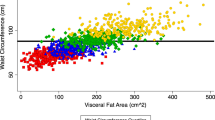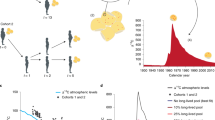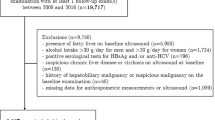Abstract
Objective: To test the null-hypothesis that no age difference in adipose tissue fatty acid composition exists independent of dietary fat intake. Design: A cross-sectional survey of coronary heart disease risk factors, the Scottish Heart Health Study, provided needle biopsy adipose tissue fatty acid data and food frequency-derived dietary data. Setting: Twenty-two Scottish Districts between 1984 and 1986. Subjects: A total of 10 359 men and women aged 40–59 y were randomly recruited in sex and five-year age bands from GP lists. A sub-set of 2308 men and 2049 women (42%) provided satisfactory adipose tissue and dietary data. Main outcome measures: Multiple regression analysis (adjusting for dietary fats, body mass index and smoking, with and without menopause status for women) of the relationship between individual fatty acids in adipose tissue and age, and between age and the ratio of linoleic acid (C18:2, n-6) to gamma-linolenic acid (C18:3, n-6) as an indicator of δ-6 desaturase activity. Results: Sex-consistent changes with age occurred for linoleate (adjusted regression slope±s.e. for men −0.299±0.1339 and for women −0.504±0.1731) and gamma-linolenate (adjusted regression slope±s.e. for men −0.141±0.0341 and for women −0.154±0.0469) both P<0.0001. These changes gave rise to a significant increase (P≤0.005) in the C18:2, n-6 to C18:3, n-6 ratio with age. Dihomo-gamma-linolenic acid (C20:3, n-6) and docosahexa- plus docosapentaenoic acids (C22:5+C22:6, n-3) also increased significantly with age (P≤0.01). For the latter, the adjusted regression slopes were far greater for women (0.596±0.0575) than men (0.131±0.0417). Conclusions: The results show that ageing does influence adipose tissue fatty acid composition independent of diet. The sex differences may partially be due to inadequate adjustment for changes in sex hormone status in males with ageing. Using the current indicator, a decline in the rate limiting step of delta-6 desaturation appeared to occur with age, and was greater in women than in men. These results may indicate that an increase in dietary gamma-linolenic acid (C18:3, n-6) is necessary with age to offset the relative imbalance between PUFA levels which appears to occur. However, any direct health benefit regarding the common diseases of ageing from such a strategy still remain to be clarified. Sponsorship: The Scottish Office Home and Health Department funded the Scottish Heart Health Study. CBS thanks Scotia Pharmaceuticals Limited for financial support.
This is a preview of subscription content, access via your institution
Access options
Subscribe to this journal
Receive 12 print issues and online access
$259.00 per year
only $21.58 per issue
Buy this article
- Purchase on Springer Link
- Instant access to full article PDF
Prices may be subject to local taxes which are calculated during checkout
Similar content being viewed by others
Author information
Authors and Affiliations
Rights and permissions
About this article
Cite this article
Bolton-Smith, C., Woodward, M. & Tavendale, R. Evidence for age-related differences in the fatty acid composition of human adipose tissue, independent of diet. Eur J Clin Nutr 51, 619–624 (1997). https://doi.org/10.1038/sj.ejcn.1600455
Received:
Revised:
Accepted:
Issue Date:
DOI: https://doi.org/10.1038/sj.ejcn.1600455
Keywords
This article is cited by
-
Age-associated changes in circulatory fatty acids: new insights on adults and long-lived individuals
GeroScience (2023)
-
Lower follicular n-3 polyunsaturated fatty acid levels are associated with a better response to ovarian stimulation
Journal of Assisted Reproduction and Genetics (2019)
-
Women's higher health risks in the obesogenic environment: a gender nutrition approach to metabolic dimorphism with predictive, preventive, and personalised medicine
EPMA Journal (2013)
-
Multiple roles of dihomo-γ-linolenic acid against proliferation diseases
Lipids in Health and Disease (2012)
-
Plasma Omega-3 Polyunsaturated Fatty Acids and Survival in Patients with Chronic Heart Failure and Major Depressive Disorder
Journal of Cardiovascular Translational Research (2012)



